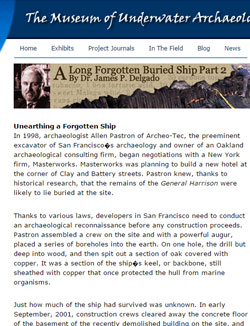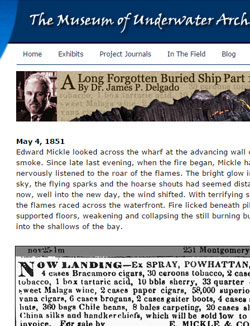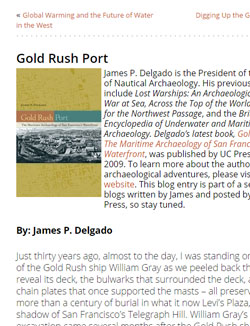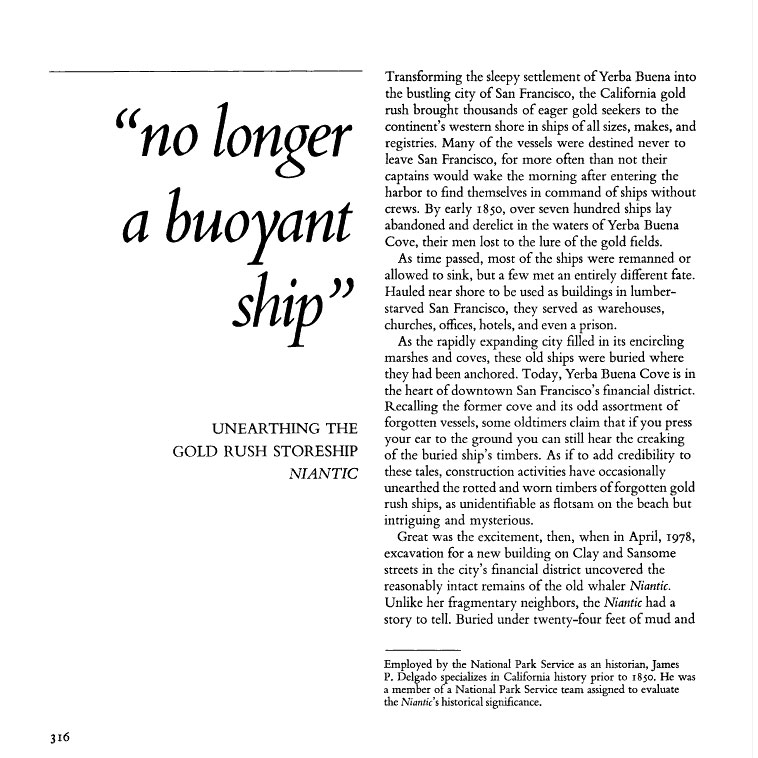
Described as a “forest of masts,” San Francisco’s Gold Rush waterfront was a floating economy of ships and wharves, where a dazzling array of global goods was traded and transported. Drawing on excavations in buried ships and collapsed buildings from this period, James P. Delgado re-creates San Francisco’s unique maritime landscape, shedding new light on the city’s remarkable rise from a small village to a boomtown of thousands in the three short years from 1848 to 1851. Gleaning history from artifacts–preserves and liquors in bottles, leather boots and jackets, hulls of ships, even crocks of butter lying alongside discarded guns–Gold Rush Port paints a fascinating picture of how ships and global connections created the port and the city of San Francisco. Setting the city’s history into the wider web of international relationships, Delgado reshapes our understanding of developments in the Pacific that led to a world system of trading. Purchase online.
Watch Jim talk about the gold rush on the Videos page.
Thousands of vessels arrived at San Francisco between 1849 and 1856, discharging thousands of passengers and more than a million tons of cargo. The first step toward creating a successful entrepôt (trading post) was to build a unique waterfront that used ships as floating buildings, wharves as streets, and buildings on pilings into which goods could flow from around the world. On this quickly built waterfront, the entrepreneurs of the time hastened to sell or repackage these goods and transship them to the interior of California and the gold mines.
Since the 1970s, Jim has been involved in digs where these ships – as well as collapsed buildings – have been encountered and archaeologically studied before construction proceeds. Most of these projects have been with his good friend Allen Pastron’s firm Archeo-Tec, who pioneered these types of digs and who has literally exhumed and documented the early history of San Francisco.
Here is a selection of articles and blogs Jim has written on the subject in chronological date order, most recent starting at the top:

Courtesy The Museum of Underwater Archaeology Blog
Excerpt: Arriving at the site, you are struck by how this small hole in the midst of all the high-rises acts like a portal to the past. Every day, hundreds of pedestrians stop, look down at the ship nestled in the mud, and stare. For those of us privileged with a closer look, it is a steep climb down a construction ladder, and then over loose sand and slippery mud until you reach the timbers of the ship. The General Harrison burned to her waterline, and so only a third of the ship’s once massive hull remain. Cleared of mud, the hold now lies largely empty.

Courtesy The Museum of Underwater Archaeology Blog
May 4, 1851
Edward Mickle looked across the wharf at the advancing wall of smoke. Since late last evening, when the fire began, Mickle had nervously listened to the roar of the flames. The bright glow in the sky, the flying sparks and the hoarse shouts had seemed distant, but now, well into the new day, the wind shifted. With terrifying speed the flames raced across the waterfront. Fire licked beneath piling-supported floors, weakening and collapsing the still burning buildings into the shallows of the bay.
This blog entry was part of a series of blogs Jim wrote about the Gold Rush ships for the University of California Press.
Excerpt: Just thirty years ago, almost to the day, I was standing on the deck of the Gold Rush ship William Gray as we peeled back the mud to reveal its deck, the bulwarks that surrounded the deck, and the chain plates that once supported the masts – all preserved after more than a century of burial in what it now Levi’s Plaza,in the shadow of San Francisco’s Telegraph Hill. William Gray’s partial excavation came several months after the Gold Rush ship Niantic was unearthed by construction at 505 Sansome, in downtown San Francisco, and the modern age of historical archaeology began in the city. I also was there for that!
Co-authored with Allen G. Pastron
Volume 25, Number 3, 1991
Historical Archaeology
Excerpt: By mid-1850, as a consequence of the California Gold Rush, hundreds of ships from around the world lay at anchor in San Francisco Bay, to the east of the rapidly growing metropolis. As the “argonauts” headed for the Gold Country, scores of these vessels were abandoned in the harbor and left to rot. As the city expanded eastward into the harbor, the least seaworthy ships were towed to the shallows off Rincon Point and scrapped. By the mid-1850s enterprising entrepreneurs commenced San Francisco’s shipbreaking trade. In 1988, construction at the Hills Plaza Site, located at the former tip of Rincon Point, encountered a substantial portion of what had been San Francisco’s largest mid-19th-century shipbreaking yard. The study of portions of Charles Hare’s Gold Rush shipbreaking facility afforded the first opportunity to document archaeologically this type of land-based maritime facility on the West Coast.

Volume 46, Number 4 (Autumn, 1983)
Huntington Library Quarterly
Excerpt: One of the strangest aspects of San Francisco during the Gold Rush was the frequent use of ships as buildings. Perched “high and dry” on the mud flats of the city’s shallow waterfront, or moored in deeper water, often housed over and subdivided, were dozens of formerly proud vessels serving as hotels, restaurants, offices, warehouses, the town jail, and a sailors’ church.
Volume 58, Number 4 (Winter 1979/1980)
California History
Excerpt: Transforming the sleepy settlement of Yerba Buena into a bustling City of San Francisco, the California gold rush brought thousands of eager gold seekers to the continent’s western shore in ships of all sizes, makes and registries. Many of the vessels were destined never to leave San Francisco, for more often than not, their captains would wake the morning after entering the harbor to find themselves in command of ships without crews. By early 1850, over seven hundred ships lay abandoned and derelict in the waters of Yerba Beuna Cove, their men lost to the lure of the gold fields.


